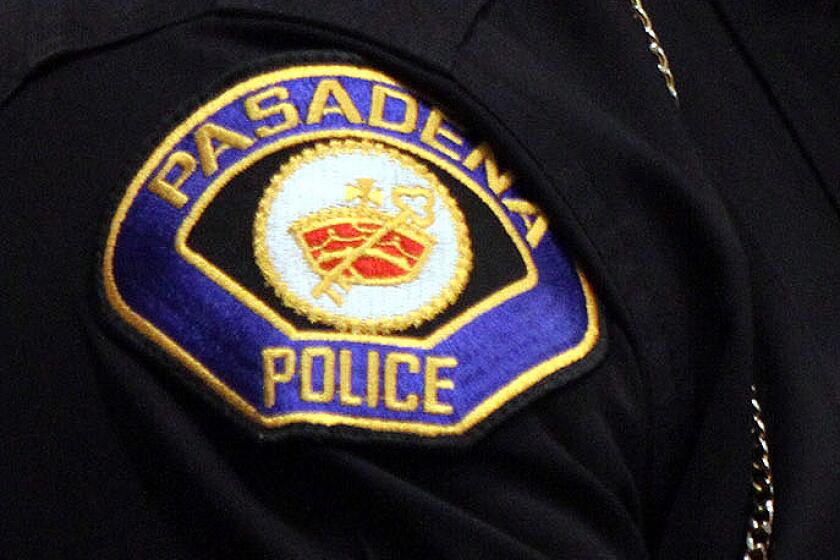Gang Crimes Drop Sharply in South L.A.
- Share via
A year ago, the Los Angeles Police Department’s South Bureau held the dubious distinction of the precinct with the city’s highest rate of gang crime.
This year, as crime continues to spiral upward in other parts of Los Angeles, gang crime in the South Bureau has dropped by more than a third. Police and community activists attribute the dramatic decline to crackdowns that have jailed thousands of gang members, along with unprecedented pressure from gang intervention and neighborhood watch programs.
Working together, Community Youth Gang Services, Brotherhood Crusade, the Nation of Islam, the Southern Christian Leadership Conference and others flooded the precinct with staff and volunteers who painted over gang graffiti, set up job development programs, initiated civilian street patrols and even organized flower-planting parties.
The result: Crime involving gang members in the 58-square-mile community was down a stunning 36% between Jan. 1 and March 31, compared with the same period a year ago, according to Police Department statistics. Murders involving gang members during the same period fell 45%.
“Up until this year, we had 50% of the city’s gang problem in South Bureau--now it’s in the low 40% range,” said South Bureau Deputy Chief William Rathburn. “I think we are seeing a significant trend and I am optimistic that we can sustain it.”
The results have been most visible in the 77th and Southeast divisions, the two South Bureau divisions specifically targeted by police and the coalition of community groups.
In the 77th Division, crimes involving gang members declined 48% during the period. In the Southeast Division, these crimes dropped by 47%.
The same trend is evident in so-called gang-motivated crimes, a narrower category of crimes that stem directly from gang activity. Typically, this category involves violence between gangs such as drive-by shootings.
Such crimes in the 77th Division fell 43% during the period. In the Southeast Division, they dropped 32%.
In the neighboring Southwest and Harbor divisions, which were not targeted for special anti-gang efforts, crimes involving gang members declined, but not as sharply. In the Harbor Division, these crimes dropped 18% during the period. In the Southwest Division, there was a 13% decline.
But when gang-motivated crimes are considered alone, the results are strikingly different. In the Harbor Division, they declined 7%, but in the Southwest Division, they skyrocketed by 57%.
Even in the areas where crime has fallen, the problems are far from solved. All agree that gang violence remains intolerably high throughout much of South-Central Los Angeles.
“We’ve made merely a good beginning,” said Danny Bakewell, Brotherhood Crusade president. “Now, it’s up to all of us who give rhetoric to the problem to demonstrate our commitment on an ongoing basis.”
The problem is immense. Encompassing a population of 550,000, the South Bureau community does not have a movie theater or even a Little League to occupy the interests of school-age children. The junior high school dropout rate is about 25%. About half of those who reach high school never graduate. Each day, an estimated 9,000 unsupervised children who should be in school are roaming the streets, authorities said.
Meanwhile, “there are more than 20,000 gang members in our area,” Rathburn said. “We still average a murder a day.”
The first sign that the anti-gang campaign was gaining ground came in November when year-end figures indicated that crimes committed by gang members in Rathburn’s jurisdiction had dipped at the same time that they were climbing elsewhere in the city. Until that point, gang crime had been on a steady increase throughout much of South Los Angeles.
The early strides coincided with a series of massive police roundups on gang-ridden streets, dubbed Operation Hammer, Rathburn said. But the dramatic reduction in crime was not seen until the police crackdowns were supplemented with the community group efforts.
Meanwhile, gang crimes have continued to mount in other portions of the city. In the Central Bureau, gang-motivated crimes jumped 34% between Jan. 1 and March 31, compared to the same period last year. In the West Bureau they were up 18%. The Valley Bureau reported a decline of 14%.
Mike Genelin, who heads the Los Angeles County district attorney’s gang prosecution unit, said the “community approach” is a crucial addition to any law enforcement strategy aimed at curbing gang violence.
Beyond that, “It is much more cost-effective to deal with gang problems with prevention measures than by sending someone to prison, which costs $28,000 a year,” Genelin said. “It’s cheaper and helps save more lives.” For now, South Bureau residents say they have begun to feel a certain sense of safety in the streets they haven’t felt in years.
“It feels more peaceful,” said Dolores Doster, a 36-year-old mother of four who has lived in the Avalon Gardens housing project for three years. “Sometimes at night you have to get up and look around because you can’t believe the silence.”
An ice cream truck driver, Guadalupe Rubalzada, 32, also said he is less anxious as he tooled along narrow housing project streets near Avalon Boulevard and Manchester Avenue in a vehicle encased in steel security bars.
Rubalzada said the security bars were installed a year ago after a drunk smashed his fist through the window of his truck.
“There is less violence now,” Rubalzada said, peering out from behind steel mesh covering the sales window of his truck. “But there are still places where it is dangerous to go--that’s why I have these bars.”
Avalon Gardens was the target of an innovative 45-day program called Taking our Community Back, which was organized by the Brotherhood Crusade and Community Youth Gang Services in part to teach people in the projects how to police themselves. At a cost of $50,000, the program was credited with closing three crack houses and reducing crime in the immediate vicinity by 60%.
“I’m not suggesting we have magic, but it was the first time that a community demonstrated it was willing to do something for itself,” Bakewell said. “Police battering rams can have an impact for a day--but not on the daily lives of the people who live there.”
Many of the gang-fighting community groups had been working independently in scattered portions of the city for years, chipping away at the gang problem but seldom concentrating their efforts on a single neighborhood.
Empowered by their success in the South Bureau, leaders of these groups say they hope to expand their joint efforts into other troubled areas of the city. No one is sure how much such an effort will cost these organizations, who say their resources already are stretched to the limit.
“This month, we will be seeking federal funds to expand our programs throughout the city,” said Steve Valdivia, executive director of Community Youth Gang Services, which counsels youths, monitors gang activity and educates the community about gangs. “If we get those funds, and there are no guarantees we will, we’ll be going wherever gang crime rates are highest.”
The additional money, if it comes, would be used to organize gang intervention and education programs, job referral services and recruit street patrols such as 100 Men Plus, which organizes adults to apply pressure on gang members in their own neighborhoods.
Larry Malbrue, 38, a construction worker and one of the group’s newest recruits, said he has evidence that these programs work.
“Gangs were after me last year and it was like a nightmare,” Malbrue said. “They pulled the license plates off my car, let air out of the tires. Carloads of gang members drove by my house throwing gang signs.”
The problem was defused when Malbrue and 20 other members of the group confronted the gang members in the street and in their homes. Instead of threatening violence, the men offered to help the gang members return to school and find jobs.
“They backed off,” Malbrue said.
CRIME DROPS IN THE SOUTH BUREAU Gang-motivated crimes dropped dramatically in two divisions of the Los Angeles Police Department’s South Bureau--77th and Southeast--targeted by police and a coalition of community and religious organizations.
Gang-motivated crimes dipped slightly or soared, however, in the bureau’s two other divisions--Harbor and Southwest--which were not targeted. Percentage figures compare 1989 and 1990 year-to-date totals for March.
GANG-MOTIVATED CRIMES 77th: -43 Southeast: -32 Harbor: -7 Southwest: +53
More to Read
Sign up for Essential California
The most important California stories and recommendations in your inbox every morning.
You may occasionally receive promotional content from the Los Angeles Times.














